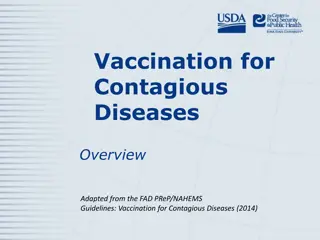Utilizing Litchi Fruit Pericarp Extract as a Natural Antioxidant in Meat Products
Oxidation is a major concern in meat products affecting quality and shelf life. This study explores the potential of litchi fruit pericarp extract as a natural antioxidant in sheep meat nuggets to combat lipid oxidation. Litchi fruit pericarp, often discarded as waste, is rich in phenolics with antioxidant properties. Incorporating this extract could help reduce oxidative deterioration in muscle foods, offering a safer alternative to synthetic antioxidants. The research highlights the valuable agri-by-product of litchi fruit pericarp and its potential applications in the food industry.
Download Presentation

Please find below an Image/Link to download the presentation.
The content on the website is provided AS IS for your information and personal use only. It may not be sold, licensed, or shared on other websites without obtaining consent from the author.If you encounter any issues during the download, it is possible that the publisher has removed the file from their server.
You are allowed to download the files provided on this website for personal or commercial use, subject to the condition that they are used lawfully. All files are the property of their respective owners.
The content on the website is provided AS IS for your information and personal use only. It may not be sold, licensed, or shared on other websites without obtaining consent from the author.
E N D
Presentation Transcript
Antioxidant effect of Litchi fruit pericarp extract in sheep meat nuggets Arun Kr Das Eastern Regional Station, ICAR-Indian Veterinary Research Institute 37 Belgachia Road, Kolkata-700037
Introduction Oxidation of lipid and auto-oxidation -major causes of quality deterioration and reduced shelf life of meat products. Changes in meat quality parameters such as colour, flavour, odour, texture and even nutritional value Meat mincing, cooking and other processing prior to refrigerated storage disrupt muscle cell membranes facilitating the interaction of unsaturated lipids with pro-oxidant substances such as non-haem iron, accelerating lipid oxidation leading to rapid quality deterioration and development of rancidity. Initially lipid oxidation in meat products results cardboard flavour and progresses with development of painty, rancid and oxidized flavour. Degree of lipid unsaturation, muscle type, animal diet, additives such as salt, cooking method, manner of storage and pH of the muscle
Introduction The rate and extent of oxidative deterioration can be reduced through various means like curing, vacuum packaging, modified atmosphere packaging and most importantly adding synthetic or natural antioxidants. Synthetic antioxidants such as butylated hydroxytoluene (BHT) and butylated hydroxy anisole (BHA) have been used extensively, recent studies have implicated them to have toxic effects. An alternate to prevent lipid peroxidation in muscle foods during processing and storage- to use natural antioxidants Fruits and vegetables are rich sources of antioxidants and can serve as a source of natural antioxidants for meat products
Litchi fruit pericarp-a valuable agri-by-product Litchi (Litchi chinensis Sonn.) is a tropical and subtropical fruit native to China, and now widely cultivated throughout the World. Litchi or Lychee, a fruit with a rough brown shell and sweet white flesh around a large shining brown seed. Well received by consumers- due to its delicious taste and possible health benefits.
Litchi fruit pericarp-a valuable agri-by-product Litchi fruit pericarp (LFP) accounts for approximately 15% by weight of the whole fresh fruit and contains significant amounts of phenolics which are usually discarded as a waste in the process. The phenolics of LFP have been confirmed to have antioxidant, immunomodulatory activities. anticancer, LFP has been considered a new source of pharmaceuticals and food industry. No literature regarding its use as natural antioxidant in muscle food system.
Objective To assess the phenolic compounds and antioxidant potential of water extract of litchi fruit pericarp powder. To study its use in muscle food products as a source of natural antioxidants to prolong quality and stability. To compare its antioxidant potential with BHT in sheep meat nuggets.
Methodology Dressed and deboned sheep meat and stored frozen at 18 C till further use. Fresh Litchi fruit pericarp was collected and dried after fine chopping in an oven at 50 C. After drying, fine powder of Litchi fruit pericarp was prepared using home mixer. Ten grams of litchi pericarp powder was added in 100 ml boiled distilled water and left for 1 h followed by filtration through Whatmann No 1 filter paper to get extract
Analytical procedures Litchi pericarp powder analysis Estimation of total phenolics Radical Scavenging activity using DPPH assay Ferric reducing antioxidant power assay Sheep meat nuggets for quality and acceptability pH and cooking yield TBARS number Sensory analysis of goat meat patties
Formulation for sheep meat nuggets prepared with litchi pericarp extract and BHT Ingredients (%) Meat Salt Ice flakes Refined oil Condiments Polyphosphate Dry spice mix Na nitrite (ppm) Wheat flour LPE (1%) BHT (100ppm) Control LPE (1%) 70.1 1.8 10 LPE (1.5%) BHT ( 100) 69.5 1.8 10 8 4 0.3 1.8 150 3 1.5 - 71.1 1.8 10 8 4 0.3 1.8 150 3 0.00 - 70.0 1.8 10 8 4 0.3 1.8 150 3 - 100 8 4 0.3 1.8 150 3 1.00 - Control: Sheep meat nuggets; LEP (1%)-Sheep meat nuggets with 1% LPE; LEP (1.5%): Sheep meat nuggets with 1.5% LPE; BHT100: Sheep meat nuggets with 100ppm BHT
Total phenolics (mg gallic acid equivalent) in different concentrations of litchi pericarp powder and BHT 0.4 Phenolics constitutes - one of the major groups of compounds acting as primary antioxidants or free radical terminators. 0.35 a Total phenolics (mg GAE) b 0.3 b Determination of total phenolics is one of important parameters to estimate the antioxidants 0.25 0.2 amount of c 0.15 Concentration dependent total phenolics in powder extract. 0.1 Litchi pericarb 0.05 0 control LPE (1%) LEP (1.5%) BHT 100
Radical scavenging activity (%) of litchi pericarb powder extract and BHT The DPPH radical has been widely used to test the free radical scavenging ability of various natural products and has been accepted as a model compound for free radicals originating in lipids The percent radical scavenging activity of LPE was increased significantly (P < 0.05) with the concentration DPPH radical scavenging activity of 1.5 LPE was comparable to the activity of 100 ppm BHT. The DPPH free radical scavenging by antioxidants is due to their hydrogen donating ability; the more the number of hydroxyl groups, the higher the possibility of free radical scavenging ability 80 a a 70 60 b DPPH (%RSA) 50 40 30 c 20 10 0 control LPE (1%) LEP (1.5%) BHT 100
Ferric reducing antioxidant power (A700) of different concentrations of litchi pericarb powder and BHT Reducing associated reductones. properties with are presence generally 0.8 the of a 0.7 Reducing power (A700) The antioxidative action of reductones is based on the breaking of free radical chains by the donation of hydrogen atom b b 0.6 0.5 0.4 Reducing power of 1.5% LPE was even significantly higher (P compared to 100 ppm BHT c < 0.05) as 0.3 0.2 The reducing power of a compound is related to its electron-transfer ability; therefore, the reducing capacity of a compound may serve as a significant indicator of its potential antioxidant activity 0.1 0 control LPE (1%) LEP (1.5%) BHT 100
Effect of LPE and BHT on pH, product yield and total phenolics of sheep meat nuggets. Parameters Control LPE (1%) LPE (1.5%) BHT ( 100) 6.21 0.03 6.20 0.02 6.22 0.02 6.19 0.02 pH 93.62 0.48 93.29 0.36 94.12 0.43 93.75 0.39 Cooking yield (%) 0.05 0.01c 0.13 0.01b 0.17 0.01a 0.16 0.01a Total phenolics (GAE)mg/g
Effect of LPE and BHT on sensory attributes of sheep meat nuggets. Sensory attributes Appearance Control 7.23 0.05 LPE (1%) 7.22 0.06 LPE (1.5%) BHT ( 100) 7.18 0.06 7.12 0.04 Flavour 7.06 0.6 7.05 0.08 7.03 0.06 6.94 0.07 Texture 7.15 0.08 7.03 0.07 7.01 0.06 7.02 0.06 Juiciness 7.07 0.07 7.13 0.04 7.15 0.05 7.17 0.05 Overall acceptability 7.18 0.05 7.08 0.06 7.11 0.06 7.05 0.07
Effect of LPE and BHT on TBARS values of sheep meat nuggets during refrigerated storage Total phenolics, radical scavenging activity and reducing powder estimation indicate that LFP powder has good antioxidant potential. 1.4 control 1.2 LPE (1%) LEP (1.5%) 1 BHT 100 So its efficiency in controlling lipid oxidation of sheep meat nuggets was evaluated during refrigerated storage against control nuggets and BHT nuggets. 0.8 0.6 0.4 TBARS values of all the products increased significantly with the advancement of storage period 0.2 0 0 day 3 day 6 day 9 day 12 day TBARS number (mg malonaldehyde/kg)
Conclusion Bestowed with phenolic compounds which have excellent free radical scavenging activity and reducing power. Extracts at 1 and 1.5% level significantly increases the phenolic contents in sheep meat nuggets and can act as a source of natural antioxidants. No adverse effect on sensory attributes of the final products. Extract significantly reduces the lipid peroxidation similar to the 100 ppm BHT thus improving the product quality and stability.
Enjoy the delicious Litchi and benefits of pericarp as natural antioxidant























